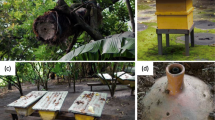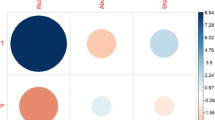Abstract
Little is known about the efficacy of sampling methods for monitoring bee communities in agricultural landscapes in sub-Saharan Africa, in general, and in Uganda, in particular. To provide baseline information on the effectiveness of different sampling methods, 26 sites with varying landscape characteristics were sampled in 2006 in agricultural landscapes in Uganda. Bees were sampled using line transect count, coloured pan trap and hand net methods. In total, 80,883 bee individuals were collected. Totals of 59, 314 and 559 bee species were recorded in transect counts, pan traps and hand nets, respectively. Thus hand nets captured the most species overall. There were few species that overlapped across the three sampling methods. Wild bees were significantly more abundant in yellow pan traps than in blue or white ones. In contrast, bee species richness was significantly higher in blue pan traps than in white or yellow pan traps. Overall, pan-trapping was found to be a complementary method to hand-netting for monitoring bee communities in Uganda.
Similar content being viewed by others
References
Aguiar C. M. L., Garofalo C. A. and Alemidae G. F. (2005) Trap-nesting bees (Hymenoptera: Apoidea) in areas of dry semideciduous forest and Caatinga, Bahia, Brazil. Revista Brasileira de Zoologia 22, 1030–1038.
Aizen M. A. and Feinsinger F. (1994) Habitat fragmentation, native insect pollinators, and feral honey-bees in Argentine Chaco Serrano. Ecological Applications 4, 378–392.
Banaszak J. (1980) Studies on methods of censoring the numbers of bees (Hymenoptera: Apoidea). Polish Ecological Studies 6, 355–366.
Banaszak J. and Manole T. (1994) Diversity and density of pollinating insects (Apoidea) in the agricultural landscape of Rumania. Polskie Pismo Entomologiczne 57, 747–766.
Baum K. A. and Wallen K. E. (2011) Potential bias in pan trapping as a function of floral abundance. Journal of the Kansas Entomological Society 84, 155–159.
Buschini M. L. T. and Woiski T. D. (2008) Alpha-beta diversity in trap-nesting wasps (Hymenoptera: Aculeata) in Southern Brazil. Acta Zoologica 89, 351–358.
Campbell J. W. and Hanula J. L. (2007) Efficiency of Malaise traps and colored pan traps for collecting flower-visiting insects from three forested ecosystems. Journal of Insect Conservation 11, 399–408.
Droege S., Tepedino V. J., Lebuhn G., Link W., Minckley R. L., Chen Q. and Conrad C. (2010) Spatial patterns of bee captures in North American bowl trapping surveys. Insect Conservation and Diversity 3, 15–23.
Frimpong E. A., Gordon I., Kwapong P. K. and Gemmill-Herren B. (2009) Dynamics of cocoa pollination: tools and applications for surveying and monitoring cocoa pollinators. International Journal of Tropical Insect Science 29, 62–69.
Giles V. and Ascher S. J. (2006) A survey of the bees of the black rock forest preserve, New York (Hymenoptera: Apoidea). Journal of Hymenoptera Research 15, 208–231.
Gollan J. R., Ashcroft M. B. and Batley M. (2011) Comparison of yellow and white pan traps in surveys of bee fauna in New South Wales, Australia (Hymenoptera: Apoidea: Anthophila). Australian Journal of Entomology. doi: 10.1111/j.1440-6055.2010. 00797.x.
Gotelli N. J. and Colwell R. K. (2001) Quantifying biodiversity: procedures and pitfalls in the measurement and comparison of species richness. Ecology Letters 4, 379–391.
Grundel R., Frohnapple J. K., Jean R. P. and Pavlovic N. B. (1998) Effectiveness of bowl trapping and netting for inventory of a bee community. Environmental Entomology 40, 374–380.
Inoue M. and Endo T. (2006) Spatiotemporal distribution and resource use of scoliid wasps (Hymenoptera) in coastal sand dunes. Entomological Science 9, 359–371.
Krug C. and Alves-Dos-Santos I. (2008) The use of different methods to sample the bee fauna (Hymenoptera: Apoidea), a study in the mixed temperate rainforest in Santa Catarina State. Neotropical Entomology 37, 265–278.
Kwaiser K. S. and Hendrix S. D. (2008) Diversity and abundance of bees (Hymenoptera: Apiformes) in native and ruderal grasslands of agriculturally dominated landscapes. Agriculture Ecosystems and Environment 124, 200–204.
Leong J. M. and Thorp R. W. (1999) Color-coded sampling: the pan trap color preferences of oligolectic and non-oligolectic bees associated with a vernal pool plant. Ecological Entomology 24, 329–335.
Magurran A. E. (2004) Measuring Biological Diversity. Blackwell Publishing Ltd, Oxford. 256 pp.
Melo P. N., Gimens M. and Neto A. O. (2009) Daily activity patterns of visits by males of four species of Eulaema (Apidae: Euglossina) to odor baits in a tropical forest fragment in Bahia, Brazil. Zoologia 26, 204–212.
Michener C. D. (2007) The Bees of the World. The John Hopkins University Press, Baltimore and London. 913 pp.
Moron D., Grzes I. M., Skorka P., Szentgyorgyi H., Laskowski R., Potts S. G. and Woyciechowski M. (1999) Abundance and diversity of wild bees along gradients of heavy metal pollution. Journal of Applied Ecology 49, 118–125.
Moron D., Szentgyorgyi H., Wantuch M., Celary W., Westphal C., Settele J. and Woyciechowski M. (2008) Diversity of wild bees in wet meadows: implications for conservation. Wetlands 28, 975–983.
Munyuli T. M. B. (2010) Pollinator biodiversity and economic value of pollination services in Uganda. PhD Dissertation, Makerere University, Kampala, Uganda. 431 pp.
Munyuli T. M. B. (2011a) Factors governing flower-visitation patterns and quality of pollination services delivered by social and solitary bee species to coffee in central Uganda. African Journal of Ecology 49, 501–509.
Munyuli T. M. B. (2011b) Farmers’ perceptions of pollinators’ importance in coffee production in Uganda. Agricultural Sciences 2, 318–333.
Munyuli T. M. B. (2011c) Pollinator biodiversity in Uganda and in sub-Saharan Africa: landscape and habitat management strategies for its conservation. International Journal of Biodiversity and Conservation 3, 551–609.
Munyuli T. M. B. (2011d) Assessment of indicator species of butterfly assemblages in coffee-banana farming systems in central Uganda. African Journal of Ecology 50, 77–89.
Munyuli T. M. B. (2011e) Diversity of life-history traits, functional groups and indicator species of bee communities from farmlands of central Uganda. Jordan Journal of Biological Sciences 5, 1–14.
Munyuli T. M. B., Kasina M., Lossini J., Mauremootoo J. R. and Eardley C. (2011) Bee Genera of East Africa (Kenya, Uganda and Tanzania), Lucid v. 3.5 Key and Fact Sheets. KARI (Kenya Agricultural Research Institute, Nairobi), TPRI (Tropical Pest Research Institute, Arusha Tanzani), Faculty of Environment and Natural Resources of Busitema University Uganda, BioNET, EAFRINET (NMK, National Museum of Kenya), CABI and University of Queensland. https://doi.org/keys.lucidcentral.org/keys/v3/EAFRINET.
Munyuli, T. M. B. (2012a) Micro, local, landscape and regional drivers of bee biodiversity and pollination services delivery to coffee (Coffea canephora) in Uganda. International Journal of Biodiversity, Ecosystem Services and Management 8, 190–203.
Munyuli T. M. B. (2012b) Butterfly diversity from farmlands of central Uganda. Pschyche 2012: 1–23 (doi: 10.1155/2012/481509).
Munyuli T. M. B. (2012c) Drivers of species richness and abundance of butterflies in coffee-banana agroforests in Uganda. International Journal of Biodiversity Science, Ecosystem Services & Management (doi:10.1080/ 21513732.2012.709539).
Munyuli T. M. B., Nyeko P., Potts S. G., Atkinson P., Pomeroy D. and Vickery J. (2012) Patterns of bee diversity in mosaic agricultural landscapes of central Uganda: Implication of pollination services for conservation for food security. Journal of Insect Conservation (doi: 10.1007/s10841-012-9488-x).
Nuttman C. V., Otieno M., Kwapong P. K., Combey R., Willmer P. and Potts S. G. (2012) The utility of aerial pan-trapping for assessing insect pollinators across vertical strata. Journal of the Kansas Entomological Society 84, 260–270.
Obrist M. K. and Duelli P. (2010) Rapid biodiversity assessment of arthropods for monitoring average local species richness and related ecosystem services. Biodiversity and Conservation 19, 2201–2220.
Potts S. G., Kevan P. G. and Boone J. W. (2005) Conservation in pollination: collecting, surveying and monitoring, pp. 401–434. In Pollination Ecology: A Practical Approach (edited by A. Dafni and P. Kevan). Enviroquest, Cambridge.
Roulston T. H., Smith S. A. and Brewster A. L. (2007) A comparison of pan trap and intensive net sampling techniques for documenting a bee (Hymenoptera: Apiformes) fauna. Journal of the Kansas Entomological Society 80, 179–181.
Souza L. D. and Campos M. J. D. O. (2008) Composition and diversity of bees (Hymenoptera) attracted by Moericke traps in an agricultural area in Rio Claro, state of Sao Paulo, Brasil. Iheringia Series Zoologia Porto Alegre 98, 236–243.
Stephen W. P. and Rao S. (2007) Sampling native bees in proximity to a highly competitive food resource (Hymenoptera: Apiformes). Journal of the Kansas Entomological Society 80, 369–376.
Toler T. R., Evans E. W. and Tepedino V. J. (2005) Pantrapping for bees (Hymenoptera: Apiformes) in Utah’s West Desert: the importance of color diversity. The Pan-Pacific Entomologist 81, 103–113.
Tuell J. K., Ascher J. S. and Isaacs R. (2009) Wild bees (Hymenoptera: Apoidea: Anthophila) of the Michigan high brush blueberry agroecosystem. Annals of the Entomological Society of America 102, 275–287.
Ulyshen M. D., Soon V. and Hanula J. L. (2010) On the vertical distribution of bees in a temperate deciduous forest. Insect Conservation and Diversity 3, 222–228.
Westphal C., Bommarco R., Carre G., Lamborn E., Morison N., Petanidou T., Potts S. G., Roberts S. P. M., Szentgyorgyi H., Tscheulin T., Vaissiere B. E., Woyciechowski M., Biesmeijer J. C., Kunin W. E., Settele J. and Steffan-Dewenter I. (2008) Measuring bee biodiversity in different habitats and biographic regions. Ecological Monographs 78, 653–671.
Wilson J. S., Griswold T. and Messinger O. J. (2008) Sampling bee communities (Hymenoptera: Apiformes) in a desert landscape: are pan traps sufficient? Journal of the Kansas Entomological Society 81, 288–300.
Wilson J. S., Messinger O. J. and Griswold T. (2009) Variation between bee communities on a sand dune complex in the Great Basin Desert, North America: implications for sand dune conservation. Journal of Arid Environment 73, 666–671.
Author information
Authors and Affiliations
Corresponding author
Rights and permissions
About this article
Cite this article
Munyuli, M.B.T. Is pan-trapping the most reliable sampling method for measuring and monitoring bee biodiversity in agroforestry systems in sub-Saharan Africa?. Int J Trop Insect Sci 33, 14–37 (2013). https://doi.org/10.1017/S1742758412000379
Accepted:
Published:
Issue Date:
DOI: https://doi.org/10.1017/S1742758412000379




